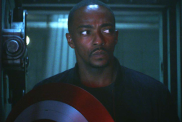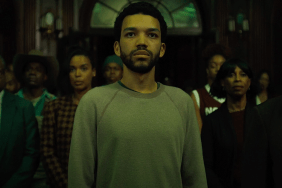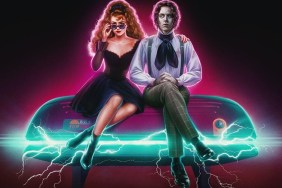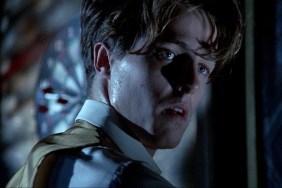
Dracula (1931)
Three films in Universal Classic Monsters have reportedly undergone complete restoration, in which every frame has been cleaned of all blemishes and artifacts and audio cleared of most every hiss and pop: Dracula, Frankenstein, and Bride of Frankenstein. Of the three, the oldest and discounting Lon Chaneys silent-film efforts the first iconic Universal monster movie is Todd Brownings Dracula, based on the seminal Bram Stoker novel and starring Hungarian actor Bela Lugosi (whod essayed the title role on Broadway) in a career-defining performance. Browning is one of the finest horror filmmakers of all time (for proof, watch his Chaney-starring The Unknown or Freaks), but his Dracula was plagued with production problems, and suffers from a stagey, uneven script and some lackluster performances, all of which prevent it from being a truly great film. Its cinematography by Karl Freund, however, is beyond reproach (particularly in the opening Transylvania scenes), and its lead performance is one for the ages. Indeed Lugosis work remains far and away the reason the films still worth watching. The light in his eyes, the hunger in his voice, and that goofy thing he does with his hands (amusingly referenced in Tim Burtons Ed Wood) create one of the screens most memorable characters.
There isnt much one can say about the image quality here, other than that its perfect. Inky blacks and stable greys, along with a soundtrack thats had a feature-length hiss removed (as explained in the discs nifty restoration featurette), combine to make Dracula look as good as the day it was released; and probably better.
The other featurettes on the Dracula disc include all those found on the films previous DVD releases, chief among them the documentaries The Road to Dracula and Lugosi: The Dark Prince. We also get two commentaries (from David J. Skal and Steve Haberman) and Philip Glasss optional score for the originally music-free film. As with all the discs in the set, theres an advertising art archive, a trailer gallery, and a still photo gallery. But the best bonus feature is an HD transfer of the Spanish-language version of Dracula (introduced by its star Lupita Tovar). Shot on the same sets but with a different cast. Its a zippier, smoother, and more energetic production, but it sadly lacks Lugosis iconic performance.
Frankenstein (1931)
Were it not for its sequel Bride of Frankenstein, Frankenstein (loosely adapted from Mary Shelleys 1818 novel) may well be considered the greatest of the Universal monster movies. In many ways its the perfect storm of talent director James Wale, actor Boris Karloff, makeup maestro Jack Pierce, visual effects expert John Fulton, even machinist/electrician Kenneth Strickfaden (whose fanciful lab equipment contributes greatly to the films birth scene). Its not perfect. Wales then-recent stage background makes some of Frankensteins scenes feel a little hollow (literally when cameras pan through walls on those sets better suited for live theater). But such complaints matter little. This film was, after all, made at what was still the dawn of sound cinema, and Whale and company did the best they could, resulting in a movie as pivotal to horror cinema as Snow White and the Seven Dwarves is to animation.
Like Dracula, Frankenstein enjoys a practically flawless restoration and transfer. The shadowed corners of Henry Frankensteins laboratory have never been more foreboding, nor the pockets beneath the eyes of Karloffs creature more simultaneously sympathetic and shiver-inducing.
Extras on the Blu-ray disc include the DVD releases The Frankenstein Files: How Hollywood Made a Monster and Karloff: The Gentle Monster, in addition to the excellent 95-minute Universal Horror documentary, narrated by Kenneth Branagh, and featuring welcome commentary from such famous monster lovers as Joe Dante and the late Ray Bradbury. Two commentaries are also made available, from Rudy Behlmer and Sir Christopher Frayling.
The Mummy (1932)
An early slow-burn from the Universal, The Mummy prefigures the moody Val Lewton RKO thrillers of the 40s, and couldnt be more different from the Brendan Fraser trilogy of pseudo-action goofiness. Karloff again stars, this time in the dual makeup role of Im-Ho-Tep (the titular mummy, who appears in the archetypal bandaged makeup and costume for only one or two shots in the opening scene) and Ardath Bay, the modern Egyptian guise he takes in order to reunite with his long lost love, the Princess Anck-es-en-Amon, now reincarnated as beautiful socialite Helen Grosvenor. Both Karloff and Jack Pierces work impress here even more than they did on Frankenstein. Through the actors underplayed performance and the make-up mans textured Ardath Bay makeup, it isnt hard to believe the character really is thousands of years old. Dracula cinematographer Karl Freund was promoted to director for this film, and he shines in the position, taking a story thats almost identical to Draculas and making a far leaner, more atmospheric film. Universal may not have done a full restoration on the film, but the studio could have fooled me. Ill be damned if I can spot a single imperfection in the transfers source material. Another beautiful job.
Extras ported from The Mummys DVD release include Mummy Dearest: A Horror Tradition Unearthed and He Who Made Monsters: The Life and Art of Jack Pierce, as well as two commentaries, from Paul M. Jensen and the team of Rick Baker, Scott Essman, Steve Haberman, Bob Burns, and sculpture studio owner Brent Armstrong.
The Invisible Man (1933)
Between Frankenstein and Bride of Frankenstein, director James Whale helmed two other classics The Old Dark House and this adaptation of the H.G. Wells novel. Claude Rains, in his screen debut, stars in the title role as a scientist driven mad by his experiments in invisibility. Though Rains face appears on screen only once in the films final shot the actor uses his voice and body language to show perfectly how his characters thirst for knowledge evolves into a longing for recognition and eventually a hunger for power. Whales cheeky sense of humor, on full display in Bride of Frankenstein, first surfaces in this film (as well as in The Old Dark House, also starring Karloff and The Invisible Mans Gloria Stuart). The film is also the most special-effects filled of all the Universal monster classics, with John Fulton and his team outdoing themselves in creating tons of still believable invisibility illusions that set the standard for The Invisible Mans many sequels, spin-offs, and remakes. Ive read a review or two that found this Blu-ray transfers image to exhibit some artifacting, but I didnt find anything that pulled me out of the film. The print appears as scratch-free as the discs Ive discussed above. At the very least, The Invisible Man looks significantly better than in it has in any of its previous home video releases.
The key extras on this disc are no less visible than those on the others in the set: chief among them the documentary, Now You See Him: The Invisible Man Revealed, and another Rudy Behlmer commentary.
Bride of Frankenstein (1935)
Ah, what can one say about Bride of Frankenstein that hasnt been said a million times before? That its James Whales best film? That its arguably the greatest American horror film of all time? That alongside Forbidden Planet, 2001, and Blade Runner its a strong contender for the title of Greatest American Science-Fiction Film? One things for certain: its Blu-ray release marks the finest restoration yet of a 1930s film on the HD format, making it the crown jewel of Universal Classic Monsters: The Essential Collection. This box set is almost worth buying for Bride alone. Seriously, its that good. John J. Mescalls lush cinematography is captured beautifully, as is Pierces makeup for Karloff (whose delivers an even better performance the second time around, helped by the decision to let the creature speak) and Elsa Lanchester, chirping and hissing in fear, confusion, and rage as his would-be mate. The daffy Una OConnor, the reliable Dwight Frye, and the manic Colin Clive all deliver solid performances. But Ernest Thesinger steals the show as the slightly campy, fully crazed Doctor Pretorius, hell-bent on creating a woman with Henry Frankenstein (a plot point many have taken to be Wales commentary on his own homosexuality). Oh how Thesingers face is captured in the stark lighting of electrical equipment during the films laboratory scene (set to Franz Waxmans weirdly luau-like theme music). Hes the Devil himself, Mephistopheles made manifest. And hes as beautiful as every heartfelt frame of this masterpiece.
Youll want to marry the Bride of Frankensteins extras over and over again (sorry), primarily the thirty-nine minute She’s Alive! Creating the Bride of Frankenstein and a commentary from historian Scott MacQueen.
The Wolf Man (1941)
After the incredible high of Bride of Frankenstein, the Golden Age of the Universal monsters soon ended, with the Hays Code in full effect, studio founder Carl Laemmle passed on, and his successor Carl Laemmle Jr. growing ill with a debilitating disease that soon ended his career as a producer. But a second wave of Universal monster movies was ushered in with 1941s The Wolf Man, starring Lon Chaney Jr. as the hapless Lawrence Talbot, who suffers the curse of the werewolf when hes bit by gypsy Bela Lugosi. Chaneys acting received its share of criticism throughout his career, but while hes no Karloff, hes perfect as cinemas quintessential lycanthrope. Jack Pierce created another iconic makeup for Chaney (one hed developed years earlier for Universals Werewolf of London, only to be thwarted by that films star Henry Hull, who wanted his face to be visible). Attaching yaks hair to Chaneys head, hands and feet, Pierce created a look that almost as iconic as that of Karloffs creature.
Like The Invisible Man, The Wolf Man Blu-ray transfer has received some criticism online for its transfer; this time ringing (the presence of edge halos) has been identified as the culprit. Maybe at 46 inches my sets too small for me to notice, but I cant say I picked up on any significant ringing, and the source print appears tight. Its picture isnt in the same league as the others Ive described above, but The Wolf Man still looks better than it ever has on the little silver disc. The audio is also a marked improvement from the films DVD release.
The Wolf Mans are worth howling over, including three docs — Monster by Moonlight, Pure in Heart: The Life and Legacy of Lon Chaney, Jr., and He Who Made Monsters: The Art and Life of Jack Pierce (repeated from the Mummy disc) and historian Tom Weavers fun, informative commentary.
The Phantom of the Opera (1943)
The first real disappointment in the Universal Classic Monsters set is one that may not be all that disappointing, as its the least of the sets nine films, the Claude Rains-starring color Phantom of the Opera. Rains delivers a typically strong performance as the star of French author Gaston Lerouxs 1911 novel about the Paris Opera House and the disfigured mystery man obsessed with its leading light, Christine Dubois (Susanna Foster); but the film cant hold a candle to Lon Chaney Sr.s lush, groundbreaking 1925 take on the tale (released on Blu-ray last year by Image). The transfers color is rich, but it has a tendency to sometimes bleed out of the edges. Audio, however, as befitting a film focused on music, is without any noticeable flaws.
The Phantom Blu-ray is haunted by the fifty-one minute documentary The Opera Ghost: A Phantom Unmasked and a commentary from historian Scott MacQueen.
The Creature from the Black Lagoon (1953)
Last but by no means least we have The Creature form the Black Lagoon, here at long last making its home video debut in 3D, the format in which it was first released in theaters. The tale of a Gill Man, who stalks and kills those who invade his Amazon home is admittedly kind of silly, and it isnt helped by a stodgy script and performances. But director Jack Arnold, Universals 1950s sci-fi specialist (who helmed the classic Incredible Shrinking Man), works the environmental theme as much as he can. And the Gill Mans costume is so good that the monster is immediately pushed into the front ranks of creature design, where it stands proudly alongside H.R. Gigers alien, while his object of desire, Julie Adams, remains the most fetching scientist this side of From Beyonds Barbara Crampton. As for the image quality, well sorry, folks I dont have a 3D TV (and I only know one person who does), so Im afraid I cant comment on the image quality of this particular transfer. But the 2D presentation is about what I expected, a step above DVD but not a quantum step, due mainly to the source material, with plenty of soft shots and murky underwater photography. Its ironic that the most recent film in the box set is in the worst condition. Fortunately, the audio track is, for the most part, beyond reproach, showcasing Henry Mancinis repetitive but effective score.
The Black Lagoons flotsam includes the forty-minute doc Back to the Black Lagoon, featuring surviving star Julie Adams, and Tom Weavers lively commentary.
One could gripe about the few faults of Universal Classic Monsters: The Essential Collection. Yes, it would be nice if we got more Blu-ray exclusive documentaries besides the brief restoration featurettes, or if other Universal classics were included. Perhaps Im too easily pleased, but Im just happy we received all the bonus features from the films previous home video releases (Ive found myself with a lot more shelf space this week). And outside of 1936s Draculas Daughter, I cant think of any five-star monster masterpieces from the studios vaults that werent included (yes, I have fond boyhood memories of 1943s Frankenstein Meets the Wolf Man too, but have you seen that movie lately?). Non-monster horror titles are another story, however, but I cant imagine when well see the Blu-ray release of The Black Cat, The Old Dark House, and other Universal classics, as well as, for that matter, MGMs brilliant Peter Lorre-starring Mad Love or Warner Brothers essential Val Lewton films. Until then, Ill enjoy the hell out of this release, which Im already eager to revisit, as its renewed my appreciation for these timeless beauties, just as its given classic movie lovers the best Halloween season in recent memory.
Stay up to date with the latest horror news by “liking” Shock Till You Drop’s Facebook page and following us on Twitter!









